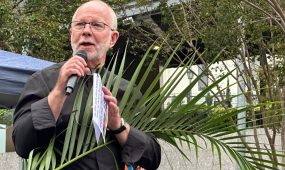Pictures, parables and perspectives
Reflections
“Sometimes just a small shift in perspective can completely change our understanding of something and from then on, we can never go back,” says Bishop Jeremy Greaves

As a child I was captivated by optical illusions. My Year 5 teacher Mr McGowan introduced me to the work of famous graphic artist M.C. Escher and I pored over his images in a school library book trying to make sense of the drawings. There were staircases that wound around and around always going up but never getting anywhere. A hand drawing a hand drawing a hand where the beginning and the end seemed interchangeable. Pictures of fish that became birds where it was never quite clear when the transformation took place.
Advertisement
A few years on I was introduced to Magic Eye books – those infuriating pictures that looked like one thing until you managed to focus (or unfocus) your gaze just right and suddenly a hidden image was revealed…and once you had seen the hidden image that was often all you could see from then on.
Sometimes just a small shift in perspective can completely change our understanding of something and from then on, we can never go back.
I recently read a short reflection on the parable of the widow and the judge (Luke 18.1-8). While Luke suggests that the parable is a teaching on prayer and the importance of persistence in prayer, commentators have always struggled to make sense of it, since scholars would argue that the explanation is a later addition – a piece of early commentary much like the explanation of the parable of the sower in Matthew 13.18-23. In the reflection I read, six words transformed my understanding of the parable and changed the way I have read it for 30 years. “What if the widow is God?” It was not a question I had ever even considered asking and having asked the question, I will never read the parable the same way again.
In his Easter sermon this year, recorded at his kitchen table, the Archbishop of Canterbury invited us to imagine a different future. He said, “After so much suffering, so much heroism from key workers and the NHS, so much effort, once this epidemic is conquered here and round the world, we cannot be content to go back to what was before as if all is normal. There needs to be a resurrection of our common life, something that links to the old, but is different and more beautiful. We must dream it because it is the gift of God. Then we must build it in partnership with God.”
Advertisement
The past few months have given us all a change in perspective. We have seen and experienced God’s church in ways we might never have imagined before. In some places, old arguments about service times have been made meaningless by online worship. In some places people have discovered new ways of praying, new ways of being the church. Whatever it is that we have learnt from this time, there is no going back, and the challenge issued by the Archbishop of Canterbury is a clarion call to action as we emerge into whatever future we imagine: “Something that links to the old, but is different and more beautiful. We must dream it… then we must build it…”
Writing in The New York Times this week, Lutheran Pastor Emily Scott, offers this challenge in slightly different terms, “Shaken from our routines, many are asking new questions. Do we really need to spend hours commuting? Should work be such a priority when our parents won’t be around forever? Why not make that change we’ve dreamed of now? Societally, there’s sudden clarity as well. We see the perilous failures of a health care system that leaves so many to fend for themselves, an economy that leaves so little margin for disaster. We can see the vast liabilities of the old life…Instead of clamoring to go “back”, we can turn, and face into a future that is uncertain, but rife with possibilities.”






